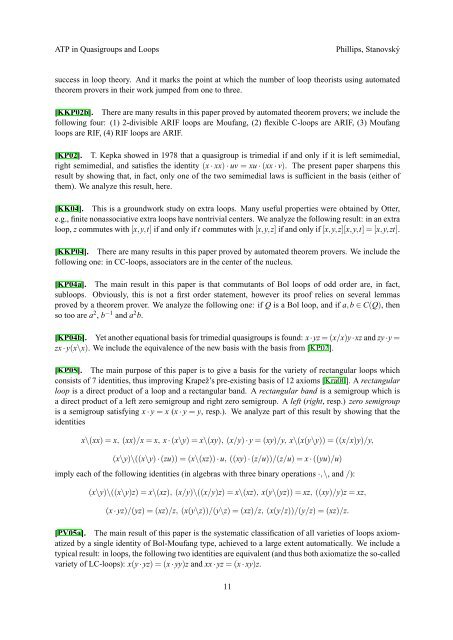Automated Theorem Proving in Quasigroup and Loop Theory
Automated Theorem Proving in Quasigroup and Loop Theory
Automated Theorem Proving in Quasigroup and Loop Theory
You also want an ePaper? Increase the reach of your titles
YUMPU automatically turns print PDFs into web optimized ePapers that Google loves.
ATP <strong>in</strong> <strong>Quasigroup</strong>s <strong>and</strong> <strong>Loop</strong>s<br />
Phillips, Stanovský<br />
success <strong>in</strong> loop theory. And it marks the po<strong>in</strong>t at which the number of loop theorists us<strong>in</strong>g automated<br />
theorem provers <strong>in</strong> their work jumped from one to three.<br />
[KKP02b]. There are many results <strong>in</strong> this paper proved by automated theorem provers; we <strong>in</strong>clude the<br />
follow<strong>in</strong>g four: (1) 2-divisible ARIF loops are Moufang, (2) flexible C-loops are ARIF, (3) Moufang<br />
loops are RIF, (4) RIF loops are ARIF.<br />
[KP02]. T. Kepka showed <strong>in</strong> 1978 that a quasigroup is trimedial if <strong>and</strong> only if it is left semimedial,<br />
right semimedial, <strong>and</strong> satisfies the identity (x · xx) · uv = xu · (xx · v). The present paper sharpens this<br />
result by show<strong>in</strong>g that, <strong>in</strong> fact, only one of the two semimedial laws is sufficient <strong>in</strong> the basis (either of<br />
them). We analyze this result, here.<br />
[KK04]. This is a groundwork study on extra loops. Many useful properties were obta<strong>in</strong>ed by Otter,<br />
e.g., f<strong>in</strong>ite nonassociative extra loops have nontrivial centers. We analyze the follow<strong>in</strong>g result: <strong>in</strong> an extra<br />
loop, z commutes with [x,y,t] if <strong>and</strong> only if t commutes with [x,y,z] if <strong>and</strong> only if [x,y,z][x,y,t] = [x,y,zt].<br />
[KKP04]. There are many results <strong>in</strong> this paper proved by automated theorem provers. We <strong>in</strong>clude the<br />
follow<strong>in</strong>g one: <strong>in</strong> CC-loops, associators are <strong>in</strong> the center of the nucleus.<br />
[KP04a]. The ma<strong>in</strong> result <strong>in</strong> this paper is that commutants of Bol loops of odd order are, <strong>in</strong> fact,<br />
subloops. Obviously, this is not a first order statement, however its proof relies on several lemmas<br />
proved by a theorem prover. We analyze the follow<strong>in</strong>g one: if Q is a Bol loop, <strong>and</strong> if a,b ∈ C(Q), then<br />
so too are a 2 , b −1 <strong>and</strong> a 2 b.<br />
[KP04b]. Yet another equational basis for trimedial quasigroups is found: x·yz = (x/x)y·xz <strong>and</strong> zy·y =<br />
zx · y(x\x). We <strong>in</strong>clude the equivalence of the new basis with the basis from [KP02].<br />
[KP05]. The ma<strong>in</strong> purpose of this paper is to give a basis for the variety of rectangular loops which<br />
consists of 7 identities, thus improv<strong>in</strong>g Krapež’s pre-exist<strong>in</strong>g basis of 12 axioms [Kra00]. A rectangular<br />
loop is a direct product of a loop <strong>and</strong> a rectangular b<strong>and</strong>. A rectangular b<strong>and</strong> is a semigroup which is<br />
a direct product of a left zero semigroup <strong>and</strong> right zero semigroup. A left (right, resp.) zero semigroup<br />
is a semigroup satisfy<strong>in</strong>g x · y = x (x · y = y, resp.). We analyze part of this result by show<strong>in</strong>g that the<br />
identities<br />
x\(xx) = x, (xx)/x = x, x · (x\y) = x\(xy), (x/y) · y = (xy)/y, x\(x(y\y)) = ((x/x)y)/y,<br />
(x\y)\((x\y) · (zu)) = (x\(xz)) · u, ((xy) · (z/u))/(z/u) = x · ((yu)/u)<br />
imply each of the follow<strong>in</strong>g identities (<strong>in</strong> algebras with three b<strong>in</strong>ary operations ·,\, <strong>and</strong> /):<br />
(x\y)\((x\y)z) = x\(xz), (x/y)\((x/y)z) = x\(xz), x(y\(yz)) = xz, ((xy)/y)z = xz,<br />
(x · yz)/(yz) = (xz)/z, (x(y\z))/(y\z) = (xz)/z, (x(y/z))/(y/z) = (xz)/z.<br />
[PV05a]. The ma<strong>in</strong> result of this paper is the systematic classification of all varieties of loops axiomatized<br />
by a s<strong>in</strong>gle identity of Bol-Moufang type, achieved to a large extent automatically. We <strong>in</strong>clude a<br />
typical result: <strong>in</strong> loops, the follow<strong>in</strong>g two identities are equivalent (<strong>and</strong> thus both axiomatize the so-called<br />
variety of LC-loops): x(y · yz) = (x · yy)z <strong>and</strong> xx · yz = (x · xy)z.<br />
11
















